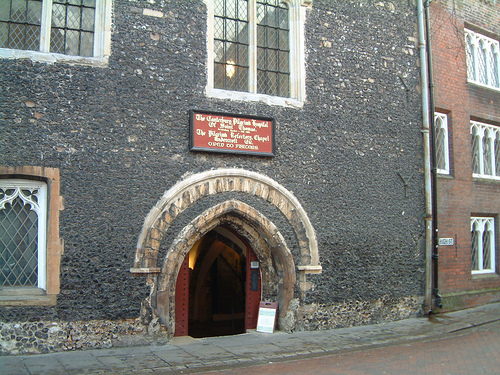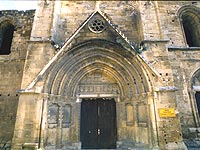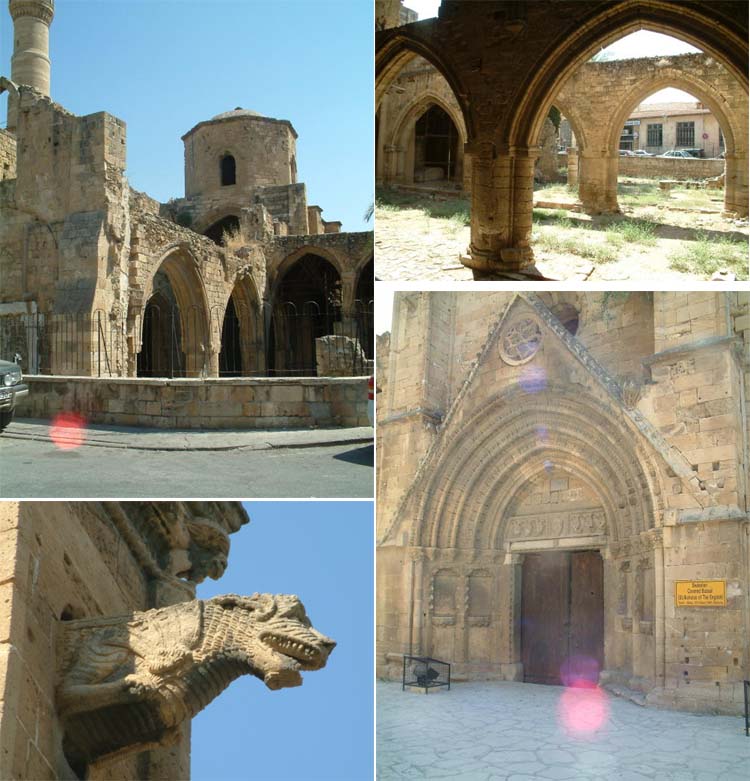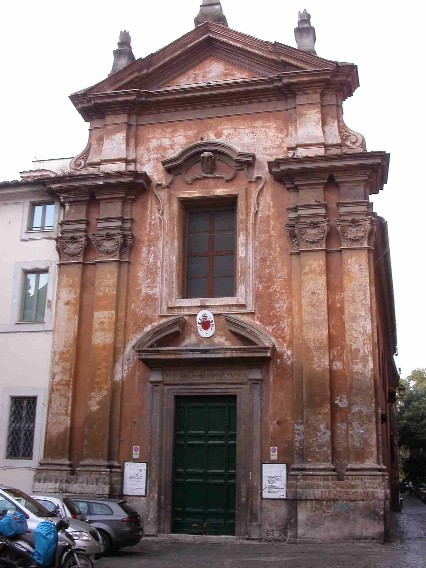 |
[ Outlaw Genealogy | Bruce
History | Lost Chords ] [ Projects | News | FAQ | Suggestions | Search | HotLinks | Resources | Ufo ] |
 |
[ Outlaw Genealogy | Bruce
History | Lost Chords ] [ Projects | News | FAQ | Suggestions | Search | HotLinks | Resources | Ufo ] |
After the capture of the city, William, Chaplain to the Dean of St. Paul's Cathedral at London, formed a small religious order, its members taking vows of poverty, chastity and obedience. The purpose of the Order was tending to the sick and wounded, and burying the Christian knights who fell in battle in the Holy Land. To that, William, as Prior of the Order, added the purpose of raising funds to ransom captives from the Muslim armies of Saladin. The success of the Order enabled it to establish a church and hospital which was dedicated to St Thomas Becket, Archbishop of Canterbury. Becket was martyred in 1170 and canonized in 1173.
During the Fifth Crusade (1217-21), the members of the Order were pressed into military service to fill the ranks of the crusader army. As a result, in 1227-28, the Order of St. Thomas of Acre was militarized by Peter des Roches, the crusader Bishop of Winchester. The Order adopted the rule of the Teutonic Knights. In 1236, Pope Gregory IX accorded Papal confirmation to the Order, and the Order became known as the Knights of St Thomas Acon (Acre being anglicized to Acon).
For the next 100 years, the crusaders held and defended the city of Acre. During this period, about the year 1279, as the purposes if the Order shifted from that of religious hospitallers to a more military role, the position of Prior, the Order's religious head, lost its pre-eminent position. After that, the pre-eminent position was accorded to the Master of the Order.
At the fall of Acre, 12 May 1291, the Master and nine knights of the Order were killed. Following the battle, the Holy Land lost to the Saracens, the Order of St Thomas, along with the Order of Knights Templar, moved their Priory to the island of Cyprus where they erected the beautiful St. Nicholas Church at Nicosia. The ruins of the Church are still standing and have been recently restored.
 History of Eastbridge Hospital
History of Eastbridge Hospital
St. Thomas Becket was murdered on December 29, 1170 in Canterbury Cathedral. Almost immediately, pilgrims came to visit his tomb and the city had to provide accommodation for them.
In 1190, Edward FitzOdbold founded a hospital on the bridge in the High Street and Becket's nephew Ralph was probably the first Master. The hospital initially prospered but declined after 150 years .
It was refounded in 1342 by Archbishop Stratford, and was probably at its peak in the 1380s when Chaucer was writing his Canterbury Tales. In Chaucer's words pilgrims 'from every shire end of England to Canterbury they wend, the holy blissful martyr for to seek'.
At this time, too, the Masters were even responsible for maintaining the East bridge over the River Stour. In the Reformation period, following the rift between Henry VIII and the Church of Rome, monasteries and places of pilgrimage came under government control and many were sold off to the rich.
In 1538, the shrine to St Thomas was destroyed and the hospital went into
decline, but in 1584 Archbishop Whitgift made reforms which were protected by Act of Parliament. The hospital had thenceforth to provide accommodation for ten poor people of Canterbury and pay dole to ten more. A school for twenty boys had already been founded in 1569, and this stayed open until the 1880s. Today the Almhouses remain and are occupied mostly by older persons who have connections with Canterbury.
Knights of St Thomas - (London)
The Hospitallers of St Thomas of Canterbury at Acre, usually called the Knights of St Thomas was a Christian Military order of the Catholic Church. Membership was restricted to Englishmen. The emblem of the order was a red cross with a white scallop in the centre and the Knights wore a white habit ...
The Order was dissolved in 1538, along with other monastic orders in England, by Henry VIII
The Dissolution of the Monasteries, sometimes referred to as the Suppression of the Monasteries, denotes the administrative and legal processes between 1536 and 1541 by which Henry VIII disbanded monasteries, nunneries and friaries in England, Wales and Ireland; appropriated their income, disposed... After the dissolution of the Order, the King offered the hospital and chapel for sale. It was purchased by the Mercers. But the buildings were destroyed in the Great Fire of London in 1666. The Mercers Company is the premier livery company of London , ranking first in the order of precedence of the "Great Twelve City Livery Companies". The present-day Mercer's Hall and Chapel, opened in 1958, are built on the site The Worshipful Company of Mercers is the only London livery company to have its own private chapel. The Bedestan
The Bedestan
The Bedestan was originally a small sixth-century Byzantine church, before the church of St Nicholas of the English was added to it in the twelfth century. The newly extended church was associated with the cult of Sir Thomas à Becket, the archbishop famously murdered in Canterbury Cathedral in 1170. During the occupation by the Venetians, the church became the Greek Orthodox Cathedral of Nicosia, but the Ottoman invasion changed its usage, as so often happened at that time. The church became a grain store and cloth market, hence its name, and gradually fell into disrepair. ...
Bedestan (St. Nicholas Church)
 The Bedestan (St. Nicholas Church) is one of the main monuments located
within the walled city of Nicosia. Originally built in the 12th century
during the Byzantine era, the Bedestan (St. Nicholas Church) is a harmonious mix
of architecture including Gothic styledoorways and Renaissance overlays,
additions made throughout the centuries. A carving of St. Nicholas found over
the main doorway was a likely addition of the 15th or 16th century. By the 16th
century, the church had become the orthodox Metropolis after being the Priory
church of the Order of St. Thomas of Canterbury. During the Ottoman period, it
was used as a "covered market place" or Bedestan.
The Bedestan (St. Nicholas Church) is one of the main monuments located
within the walled city of Nicosia. Originally built in the 12th century
during the Byzantine era, the Bedestan (St. Nicholas Church) is a harmonious mix
of architecture including Gothic styledoorways and Renaissance overlays,
additions made throughout the centuries. A carving of St. Nicholas found over
the main doorway was a likely addition of the 15th or 16th century. By the 16th
century, the church had become the orthodox Metropolis after being the Priory
church of the Order of St. Thomas of Canterbury. During the Ottoman period, it
was used as a "covered market place" or Bedestan.
Presently, the Bedestan is in overall poor condition with a collapsed roof and
structural damage.
IV. RALPH OUTLAW, born ca. 1595. Married Elizabeth
Kempe ca. 1615-16. He died July 4, 1671.
Children: (1) Thomas; (2) Rev. Ralph Outlaw; (3) Elizabeth; (4) Mary; (5)
Robert, Sec. V; (6) Charles; (7) Edward
V. ROBERT OUTLAW, (IV-III-II-I) our prime suspect as being a father of Capt. John and
Edward.
An earlier and famous Kempe lady is Margery Kempe and she is from the neighborhood King's Lynn! And she visits Hospital of St Thomas of Canterbury in Rome!
Margery Kempe (c. 1373 – after 1438) is known for writing The Book of Margery Kempe, a work considered by some to be the first autobiography in the English language. This book chronicles, to some extent, her extensive pilgrimages to various holy sites in Europe and Asia.
She was born Margery Brunham in King's Lynn (then Bishop's Lynn), Norfolk, Kingdom of England and married at the age of 20 to a local man named John Kempe, with whom she had 14 children. Her father, John Brunham, was a merchant in Lynn, five-time mayor, Member of Parliament and merchant whose fortunes may have been negatively affected by downturns in the economy, especially in the wool trades, of the 1390s.
Kempe was tried several times for such illegal acts as allegedly teaching and preaching on scripture and faith in public, and wearing white clothes (interpreted as hypocrisy on the part of a married woman). She proved her orthodoxy in each case.
The hospital is located on Via Monserrato, at the top of the Piazzetta di Santa Caterina della Rota, and near the Campo dei Fiori. The English community appears to have settled in this area in the 13th century (Margaret Harvey, The English in Rome, 1362-1420: Portrait of an Expatriate Community, Cambridge, 1999). The Collegio Inglese was founded by Gregory XII, within the complex is a church dedicated to St. Thomas, and the hospital. Originally constructed in the 8th century, the church was rebuilt in 1575, again in 1685 and again in 1866. The articulation of the facade remains medieval in appearance, including the arcades and portal detailing.
The early Christians talked about being trained at the school of the martyrs. The school of the English martyrs is no mere metaphor. Visitors to Rome can find the school if they head to the magnificent Palazzo Farnese (designed, in part, by Michelangelo), turn onto the Via di Monserrato in the heart of Rome, and walk to a nondescript door. Behind that plain door lies the Venerable English College, the oldest English institution outside of England, dating back to 1362, when it was a hospice for pilgrims.
 Santa Caterina della Rota
- St. Catherine of the Wheel. Located just off Piazza Farnese, on Via
Monserrato, the church is opposite the Hospital of St. Thomas of Canterbury
and the English College. S. Caterina is one of the oldest titular (parish)
churches in Rome
Santa Caterina della Rota
- St. Catherine of the Wheel. Located just off Piazza Farnese, on Via
Monserrato, the church is opposite the Hospital of St. Thomas of Canterbury
and the English College. S. Caterina is one of the oldest titular (parish)
churches in Rome
This is thought to be one of the oldest churches in the area, and was at first dedicated to Santa Maria in Catarina. It has this name in a papal bull of 1186, where it is described as a parish church.
The name "Catarina" originally meant "chains", and the legend is that Christian captives who had been ransomed from Muslim pirates used to be accommodated in a hospice adjacent. They allegedly hung their chains in the church in thanksgiving. With time the meaning was forgotten, and the church was called Sante Maria e Caterina (Mary and Catherine) and finally simply Santa Caterina after the martyr of Alexandria in Egypt. In the 16th century it was rebuilt to a design by Ottaviano Mascherino, and formally rededicated to her. The "rota" suffix refers to the spiked Catherine wheel on which she was tortured, according to her legend.
| - - - -
YEARS OF PILGRIMAGE AND ECCLESIASTICAL INVESTIGATION,
1413–1418
In the autumn of 1413 Margery Kempe settled her own and her husband’s debts,
perhaps with an inheritance from her recently deceased father, and set off for
the Holy Land (p. 60). Frequently short of money on her travels, but
inclined to give to the poor whatever she received, she was at once the subject
and object of charitable giving. At times the gift of money was accompanied by a
request that she should pray for the donor, as in the case of Bishop Philip
Repingdon. She may have financed her travels in part by such means. It was very
unusual in the late Middle Ages for women to travel to Jerusalem. Those who did
make the pilgrimage were usually nuns, in the company of other nuns, or married
women travelling with their husbands. Nuns on pilgrimages, as well as lay women,
were subject to satirical and misogynist attack throughout the Middle Ages. A
list of German pilgrims to the Holy Land, 1346–1588, names no women.61
On the spring voyage of 1458, as documented by Roberto da Sanseverino, Gabriele
Capodilista, Giovanni Butigella, Anton Pelchinger, an anonymous Dutch pilgrim,
and William Wey, there were no women.62 The Jerusalem pilgrimages of
Margery Kempe, St Bridget of Sweden and Chaucer’s fictitious Wife of Bath are
so well known that it is easy to overlook the exceptional fortitude and
determination required of women travelling across the Alps, voyaging in pilgrim
galleys, and facing the hardships of travel in the Holy Land, where the pilgrims
were overseen by Saracens. Pilgrims were captured in the Holy Land on numerous
occasions, for instance in the year 1404.63 From 1408 there was
legislation in Venice for the compulsory defence of pilgrim galleys after
attacks in which people had been killed, wounded, or sold into slavery. In 1417
steps were taken to prevent extortion, malnutrition and maltreatment of pilgrims
by the captains of the vessels. A galley carrying 170 pilgrims required 140
persons for management and defence, including twenty crossbow men.64
Margery Kempe travelled in a small company of pilgrims by way of Norwich to
Yarmouth, and from there to Zierikzee in Zealand (p. 60), in the autumn of 1413.
The book describes in some detail the hostility of her fellow pilgrims,
including the priest appointed as her confessor, during the pilgrimage: their
cutting of her skirt – sometimes interpreted as indicative of alleged
immorality – the alienation of her maidservant, and the pilgrims’ refusal to
keep her in their company after reaching Constance. In Constance she received
assistance from an English friar who was papal legate, and made the acquaintance
of William Weaver, a man from Devon who accompanied her to Bologna (pp.
61–63).
...
In Rome she finally followed the instruction to put on white clothing.
She visited the former servant of St Bridget and the chapel dedicated to the
saint. She was initially received at the Hospital of St Thomas of Canterbury
in Rome, but the slander of her earlier pilgrim company resulted in her
being evicted over the winter months 1414–1415.
...
The focal point of Margery Kempe’s time in Rome was the elaborate revelation
of mystical marriage to God the Father, on St John Lateran’s Day, 9 November
1414, in the Church of the Apostles (pp. 86–87). From this time, for sixteen
years, a flame of love burnt in her heart (88/28). After months of hardship,
poverty, begging, serving the poor, and after borrowing money from Richard the
broken-backed man which she immediately gave away and undertook to repay two
years later, she was invited back to the Hospital of St Thomas. Eventually a
priest from England furnished her with the means to return home, and after
Easter 1415 they set out on the return journey. The priest was fearful of
brigands on the way, but Margery Kempe reassured him (pp. 99–100), and they
returned safely to Norwich via Middelburg in Zealand. There is no mention in the
book of the hostilities between England and France which were to culminate a few
months later in the battle of Agincourt.
On her return to Norwich, Margery Kempe was welcomed by some and criticised or ostracised by others. She once more dressed in white clothing, wearing it for the first time on Trinity Sunday (104/3–26). Her husband came to Norwich to meet her, and they returned to Lynn together, where she became dangerously ill. She recovered, but was abused by the people of Lynn: some spat at her in horror of her cries and shrieks, convulsions and change of colour (105/18–24), all of which phenomena were familiar to the Carthusian monks of Mount Grace who annotated The Book of Margery Kempe and recognised them as signs of grace and holiness.72
Margery Kempe's spiritual biography is often called the first autobiography in English. A married woman who attempted to live a life devoted to Christ, Margery sought official Church recognition for her status as a spiritual woman and mystic, while continuing to live and travel in the secular world. She experienced intense emotional visionary encounters with Christ, which have at times a strikingly homely quality. Her Book, dictated by her to a scribe, records these visions as well as her travels in Europe and pilgrimage to Jerusalem. Her particular spiritual trial, according to her Book, was to be misrepresented, persecuted, and rejected by many of her clerical and lay peers. The recording of her spiritual life, despite severe difficulties and her own illiteracy, became a symbolic act in itself, representing both her claim to spiritual status and evidence of her special relationship with God. Rich in detail about the people and places Margery encountered, the Book is a rich and fascinating record of life in turbulent early 15th century England....
Saint Catherine
- The patron of Philosophers, Theologians and Royal women
Born: c287 in Alexandria, Egypt
Memorial Day / Feast Day: November 25th
Date of Death: Saint Catherine died in A.D. 307
Cause of Death: Beheaded
Who or what is Saint Catherine the patron saint of?
Saint Catherine is the patron of Philosophers, Theologians and Royal women. Meanings, definition and origins - a patron is considered to be a defender of a specific group of people or of a nation. There is a patron for virtually every cause, profession or special interest. Prayers are considered more likely to be answered by asking a patron for intercession on their behalf.
The Story and History of Saint Catherine
Catherine of Alexandria (also now known as Saint Catherine of the Wheel) was of noble birth, the daughter of Constus, governor of Alexandria in Egypt. She was extremely well educated and was receptive to new ideas. She converted to Christianity and started to preach the faith to many learned people. At this time Gaius Valerius Galerius Maximinus (c. 270 - 313) and Roman emperor from 308 to 313 was persecuting Christians. Emperor Maximinus offered Catherine a royal marriage if she would deny her faith in Christianity. She refused and was scourged and thrown into prison. The wife of the Emperor became curious about the young girl and was converted to the faith by her teachings, as were many Roman soldiers. When the emperor discovered this they were all put to death. Catherine was broken on the wheel and then beheaded.